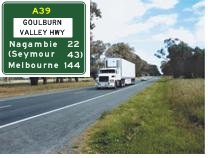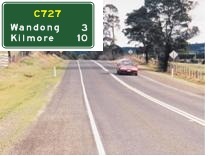Victoria's road network
The management, maintenance and development of Victoria's roads is shared between VicRoads, municipal councils, Transurban, Connect East , Southern Way, the Department of Environment, Land, Water and Planning and other government departments.
Funding for roads
Funding for Victoria’s road network comes from federal, state and local government sources, except for privately operated freeways which are funded by the private owners and operators.
Freeway and arterial roads
The majority of Victoria's traffic is carried on freeways and arterial roads. These roads provide the principal routes for the movement of people and goods between major regions and population centres of the State, and between major metropolitan activity centres, together with links to major freight terminals and tourist areas in both rural and metropolitan areas. These routes provide a safe, efficient and integrated road transport system for the economic and social benefit of the community. VicRoads arranges for freeways (excluding privately operated freeways) and arterial roads to be upgraded and constructed as necessary. For example, upgrades may be needed to accommodate changes in population size and location and increased road use for freight, business and private travel.
VicRoads is also responsible for the ongoing maintenance of these roads. See more information on VicRoads maintenance activities.
You can search for freeways and arterial roads anywhere in Victoria using the Maps of Declared Roads.
Classification of freeways and arterial roads
VicRoads must consider the following principles before declaring a road to be a Freeway or Arterial Road. These principles are described in section 14 of the Road Management Act 2004(External link), which also sets out the form of notice and procedures that apply to such a declaration.
VicRoads must consider if the road:
- provides a principal route for the movement of people and goods:
- between major regions of the State; or
- between major centres of population or between major metropolitan activity centres; or
- to major transport terminals; or
- across or around cities; or
- is a major route for public transport services; or
- has State-wide economic or tourism significance; or
- provides necessary connections between arterial roads.
Facts and benefits of the road network
- There’s approximately 150,000 kilometres of roads open for general traffic (from major freeways to minor local roads) and a further 50,000 kilometres of other minor roads and tracks in parks and forests.
- The 23,000 kilometres of freeways and arterial roads managed by VicRoads are valued at around $27 billion.
- The Victorian arterial road network carries approximately 350 million tonnes of freight.
- Almost all goods in the metropolitan area and more than 80 per cent of goods in country Victoria are transported by road.
- Much of the Victorian economy, including tourism, depends on the efficient and effective management of the roads.
- Efficient freight routes and links are essential to reduce the costs of transport to local and overseas markets.
Road types and responsible authorities
The following information explains the organisations that are responsible for each type of road in Victoria.
Note 1: Further information on the allocation of operational responsibilities between VicRoads and municipal councils on arterial roads (as the relevant responsible road authorities) can be found in the Code of Practice for Operational Responsibilities for Public Roads. These operational responsibilities include such activities as the construction, inspection, maintenance and repair of road infrastructure.
Victoria's route number signs
Show more
VicRoads has implemented a Statewide Route Numbering Scheme throughout rural Victoria. This is a simple route numbering system for rural freeways and arterial roads. Each road is given a letter and an identifying number.
- The letter assigned to each road reflects the quality and function of the route. It allows drivers to anticipate the driving conditions they are likely to encounter and to plan their trip in advance.
- The route numbers help drivers navigate around rural roads, particularly when they are travelling in unfamiliar areas. The new signs are providing a significant benefit to tourists, making travel in Victoria much easier.
The Statewide Route Numbering Scheme has been implemented along all M, A, B, and C routes. Producers of the major road directories have included route numbers on their maps. The program has been implemented in conjunction with Tourism Victoria's Statewide Tourist Signing Program.
M Roads
'M' roads provide a consistent high standard of driving conditions, with divided carriageways, four traffic lanes, sealed shoulders and line marking that is easily visible in all weather conditions. 'M' roads are the primary road links connecting Melbourne and other capital cities and major provincial centres. Examples of 'M' roads are the Princes Freeway (M1) and the Hume Freeway (M31).
A Roads
'A' roads provide a similar high standard of driving conditions on a single carriageway. 'A' roads serve the same purpose as 'M' roads, but carry less traffic. An example of an 'A' road is the Princes Highway West between Geelong and Warrnambool (A1).
B Roads
'B' roads are sealed roads, wide enough for two traffic lines, with good centre line and edge line marking, shoulders, and a high standard of guidepost delineation. 'B' roads provide the primary link for major regions not served by 'A' roads and for highly significant tourism regions. Examples of 'B' roads are the Great Ocean Road (B100) and the Alpine Road (B500).
C Roads
'C' roads are generally two lane sealed roads with shoulders. 'C' roads provide important links between population centres and between these centres and the primary transport network. An example of a 'C' road is the Geelong-Portarlington Road (C123).
Drivers Guide to Rural Victoria
This guide shows the route numbers assigned to our major road links between regional cities and towns, as well as information on roadside rest stops and facilities. It will greatly assist tourists and travelers which in turn will assist to boost tourism in regional Victoria.
To get a copy of the Drivers Guide to Rural Victoria, visit our online bookshop or call us on (03) 8391 3255.